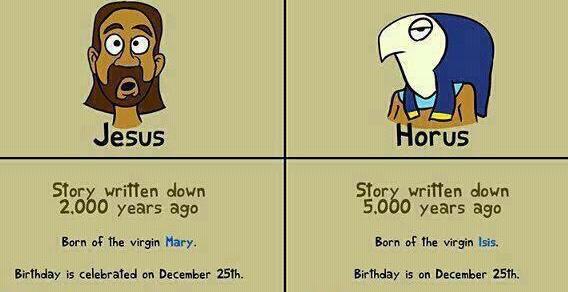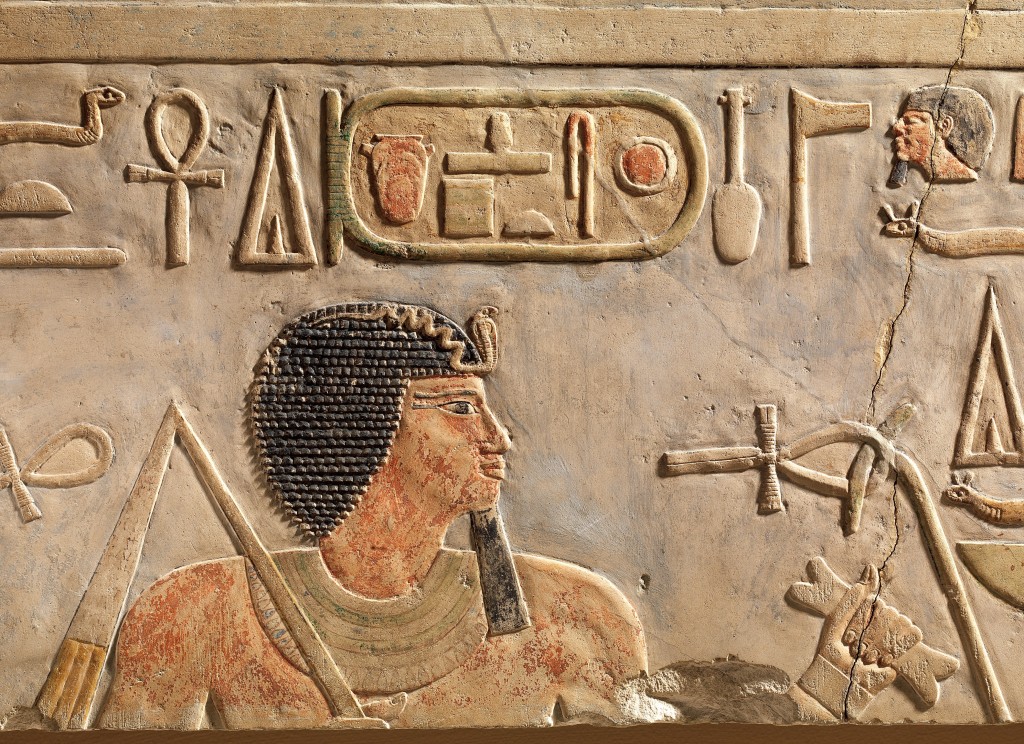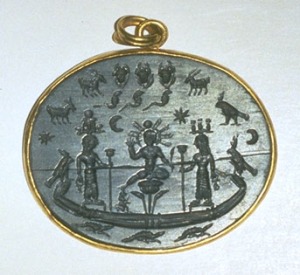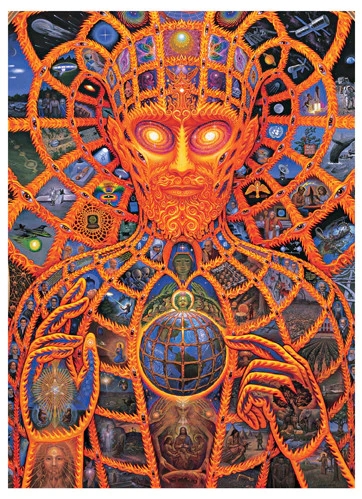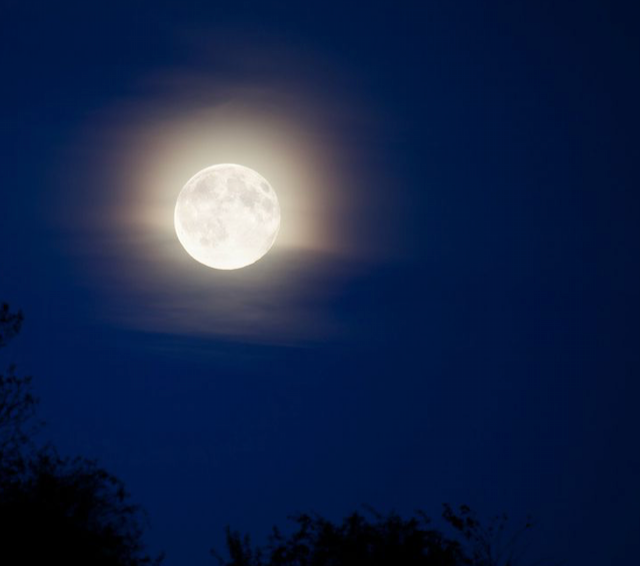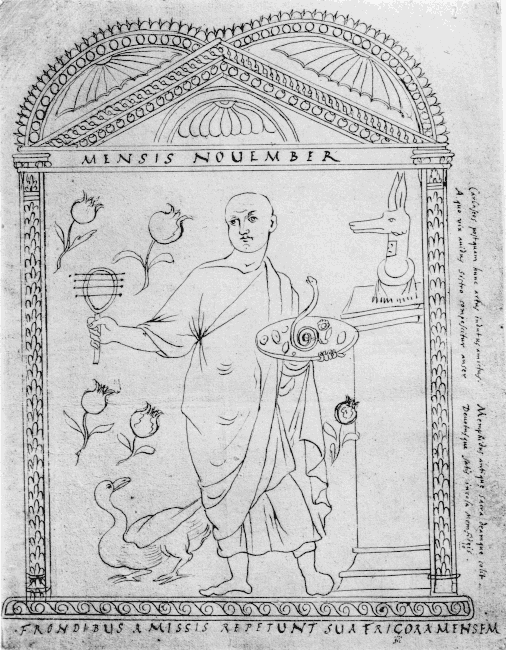We gazed at the waning light of the moon last night.
Its cool, pale light was beautiful, and yet sad. That’s often how this time of year feels. Beautiful. And sad. For at this time of year, many of us remember our Beloved and Honored Dead.
Some of us might celebrate the solemn rites of Samhain—from a quite different culture than that of ancient Egypt. (In my community, we’ll celebrate our rites next weekend.)
Now, of course you’re quite right that the ancient Egyptians did not celebrate Samhain. Yet we know they honored their dead. Indeed, their dead could be very, very present for them, as transfigured spirits, akhu, who could help them in their day-to-day lives—or cause them trouble.
But for Isis devotees seeking a more Egyptian way to mark this time of year, I’d like to introduce you to the Isia.
A festival called the Isia is found in a calendar from 354 CE that was commissioned by a wealthy Roman Christian named Valentinus from a prominent, also-Christian scribe named Philocalus. The Calendar of Philocalus is famous because it contains the first known reference to the Christian holiday of Christmas as an annual festival of the birth of the Christ on December 25th. (There are earlier references to that date, but not as an annual festival.)
But for Isiacs, the calendar is important for its inclusion of a different festival: the Isia. Philocalus records the dates of the Isia as October 28th-November 1st. Some scholars also include the days until November 3rd as part of the Isia. That’s because Philocalus’ calendar has what was known as an “Egyptian Day” on November 2nd and a Hilaria on November 3rd, both of which may have been included in the Isia.
Let me explain: to the Romans, an “Egyptian Day” was a bad luck day. There were three in January and two in every other month. The first Egyptian Day in November fell right after the Isia, on November 2nd. These days were inappropriate for public festivals, sacrifices, and were generally stay-in-your-house-and-do-nothing days. The bad luck of the Egyptian Days continued on into medieval Christian calendars.
Why were they called “Egyptian” days? No one knows for certain. However, Egyptian calendars (for example, the famous New Kingdom Cairo Calendar) often list festivals along with auspicious and inauspicious days. So it may well be that Romans simply picked up these genuinely Egyptian bad luck days and put them into their own calendar. (This tells you how influential the worship of The Egyptian Gods—mostly Isis and Sarapis—were.) Later on, the name was taken to refer to the ten biblical plagues of Egypt to better harmonize these pagan-y days with scripture.
As for the Hilaria, there are two shown on Philocalus’ calendar, one on March 25th, at the end of a lengthy festival of Magna Mater/Kybele in which the death of Attis is mourned. The preceding day (the 24th) was the Day of Blood, on which flagellation and self-castration might take place, and it was also an Egyptian Day. The Hilaria was what it sounds like: a day of joy. People played games and feasted. Some scholars think that the spring Hilaria could be the origin of our April Fool’s Day.
So clearly, it was not absolutely unheard of to have a festival on an Egyptian Day…of course in the case of the Kybele festival, it was the (yikes!) Day of Blood. There is nothing else listed in Philocalus’ calendar for the Egyptian Day following the Isia. The November Hilaria is shown as the day after that, on the 3rd.
Yet in both cases, we have a Great Goddess with a partner to be mourned, followed by a Day of Joy. This makes very good sense from a psychological standpoint; we need relief after mourning. So it may be that we should include the Egyptian Day and the Hilaria following the Isia as part of the Isia festival after all. Which would mean that (here in the northern hemisphere) we’re approaching the festival right now. So there’s time to prepare should you choose to celebrate your own Isia.

Artist’s depiction of ceremonies at the Temple of Isis, Pompeii. Click to see it larger.
We know little else about the Roman Isia. On one hand, this frees us to create our own Isia. Given the time of year, we might choose to connect the Isia with the modern festival of Halloween. Isis is, after all, a Goddess of the Dead par excellence. There is much we could do with an Isia in which we remembered our own Honored Dead, for example by speaking their names and making offering in the ancient Egyptian tradition.
On the other hand, there is an appropriate Egyptian option for the celebration of the Isia and—and given the timing and the resonant subject matter—it is a likely candidate for the basis of the Roman Isia.
Though perhaps it should more rightly be called the Osiria. For at about this same time of year, in the Egyptian month of Khoiak, the ancients held a festival for Osiris that remembered His conflict with His brother Set, His death, and His resurrection through the holy magic of Isis. We know of this festival from the period of the Middle Kingdom and have a decent record of it from the great Osirian sanctuary of Abydos. We also know of it from the Osiris chapel in Hathor’s Ptolemaic sanctuary at Denderah.
The festival re-enacted the central Isis-Osiris myth (I won’t recount it here; you all know the story.) The Egyptians molded images of Osiris from Nile mud, special spices, talismanic stones, and seeds. The images were watered so that the grain sprouted, a fitting symbol of new life. (We should also know that this was about the time of year when the Nile flood was receding so that the fields could be planted with new crops.) The festival ended with the raising of the Djed pillar, symbol of the resurrection of the God Himself as Lord of the Otherworld.
If you are so inclined, now is a perfect time to re-enact that core Isiac myth—if on a smaller and more personal scale. And should you do so from Isis’ point of view, it would be a true Isia, indeed.
I have done my own private Isia like this: I shuffle and deal out 14 Tarot cards, representing the 14 parts of the body of Osiris. I place or “hide” the cards in a circle around my temple. Then, during the several days of the festival, I ritually circle the temple, “finding” some of the cards until I have “found” them all. Then I assemble them into a roughly human-shaped, stick-figure Osiris. (This is a fairly large spread, so I place it in the middle of the floor of my temple.) On the last day of the festival, I turn over the cards, revealing them, and read them as an omen for the coming season and coming year. Naturally—to expand the rite and get myself in the proper magical frame of time, I use temple openings and closings of my choice from Isis Magic. (The Opening of the Ways works quite well; if you haven’t got your own copy of Isis Magic, you’ll find the ritual here.)
Should you decide to honor the Isia this year—in this way or some other—I would love to know about your experience. Whether you choose to connect your Isia with the ancient Khoiak festivals of Isis and Osiris, create a Day-of-the-Dead-type Isia, or celebrate some other way entirely, I wish you much depth and beauty in this darkening season of sad, sweet remembrance. May She embrace you always.
Isis and the pharaoh raise the Djed pillar, the symbol of the resurrection of Osiris










